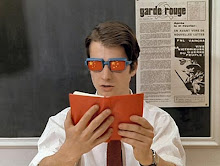In the 1930’s, Bonnie & Clyde were folk heroes. They robbed and murdered people, but in the desperate climate of the Great Depression the duo were championed by many members of the disaffected American populace. Gangsters like John Dillinger and Pretty Boy Floyd also fed the public’s hunger for outlaws, and Hollywood exploited this phenomenon by producing such films as LITTLE CAESAR, THE PUBLIC ENEMY and SCARFACE. These motion pictures presented riveting protagonists with morals that were deficient or even completely vacant, lacking true human dimension and doomed by their respective movie’s denouements. Always vibrant and sometimes sympathetic, these characters were still depicted as aberrant in their tragic fates and not at all the type of people you'd actually want to meet outside a movie theater. This mode of storytelling is still well established in the cinema, but anyone with even a mild knowledge of film history knows that the presentation of the criminal, or of the outlaw in a friendlier fictive terminology, has broadened considerably. The emphasis has shifted from simply bold and perhaps sympathetic to romantic and larger than life, with THE GODFATHER films, Michael Mann’s THIEF, and Anton Corbijn’s recent THE AMERICAN being just a minute sample of this development. The characters might still be doomed, but hey, aren’t we all?
Julian Duvivier’s 1937 classic PÉPÉ LE MOKO is often synopsized as an example of French poetic-realism that inspired a better known American remake (ALGEIRS), but it’s also an early and effective shift away from the tendency to present the criminal as simply pathological. The iconic Jean Gabin stars as the titular character, and his role unsurprisingly portrays an operator as smooth and complex as he is outside the law and potentially volatile. Not only does he have intense good-looks and magnetic charisma (you know, the women want him and the men want to be him), but he also possesses a moral code, a sense of honor and a propensity for sincere human emotion (love inspires him to sing! TO DANCE!). Surviving in the stronghold of the Algerian casbah largely through the loyalty of its denizens, Pépé engages in an extended exercise of cat and mouse with his counterpart, an opposite number from the respectable side of the law Inspecteur Slimane, their activity seeming likely to extend until one of the two characters either retire or expire. Except the introduction of a femme fatale (naturally) in the guise of slumming rich girl Gaby complicates matters, for she represents the freedom of Paris and increasingly positions the casbah as Pépé’s exotic prison. If you’re suspicious or disdainful of the romanticisation of the gangster, please keep in mind that the guts of this film take place under the rather distasteful (though undeniably lavish) environment of French colonialism.
I’m not insinuating that Pépé be absolved of his status as thief and cutthroat, only that his failings in the film are presented as human deficiencies which are ultimately preferable to the sly subtext of systematic repression. A better claim against the film could be made over its representation of women: not only is Gaby Gould the kind of shallow broad that’s always leading a likeably fallible dude to his demise, but Inès, Pépé’s spurned former lover, deteriorates by movie’s end into a fatally jealous slattern. No, Duvivier’s film is assuredly not perfect, and while it undoubtedly forecasts the complex shading of the 20th Century criminal, it also lacks the ever-contemporary quality of well rounded human portraiture (this means women as well as men, the rich as well as poor) of his counterpart Jean Renoir. However, very much in PÉPÉ LE MOKO’s favor is a vivid directorial style.
In its early minutes comes an extended voiceover combining with a smooth avalanche of visual information that concisely and electrically details the exoticism of locale. Duvivier’s arsenal includes sharp tight camera movements, controlled edits and wild cross-cutting, painterly wide-shots of the casbah, an excellent use of shadow and a non heavy-handed employment of symbolism. The man’s flair is rather choice in a nutshell, holding elements that later helped define Neo-realism and film-noir, if in the end proving too artificial for the former and too bright for the latter. No, its strongest stylistic connection concerns the Nouvelle Vague.
For me, a key scene in PÉPÉ LE MOKO concerns an old woman reflecting upon her youth as a vocalist, playing one of her records on a wind up Victrola and singing along with deep emotion. It is the sort of beautifully indulgent scene that would fit perfectly in one of Godard’s early films, except for the tears. This distinction is quite important. Duvivier’s scene welcomes sentiment; the New Wave so often favored detachment. And while Pépé’s walk to his poetic fate comes as no surprise, it’s telling that in the end it is he that decides his fate. Not a tragic figure, but just one of countless doomed individuals with blood on their hands….
Julian Duvivier







No comments:
Post a Comment